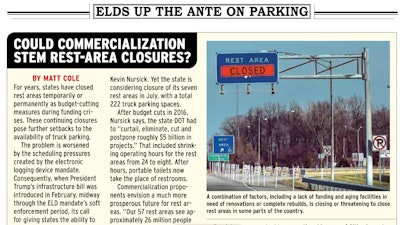In the wake of the publication of Matt Cole’s brief “Could commercialization stem tide of rest area closures?” story, part of our “ELDs up the ante on parking” feature series, also featured in the June print issue of Overdrive, National Association of Truck Stop Operators President and CEO Lisa Mullings offered an op-ed response.
 Access Cole’s original report from the June 2018 Overdrive issue via this link.
Access Cole’s original report from the June 2018 Overdrive issue via this link.Mullings noted it was “reasonable” that Overdrive would ask the question in the story’s title, but she believed the question “should have been revised to focus on the real problem: whether rest area commercialization would result in more parking.”
Mullings and NATSO endorse the notion that the opposite would ultimately occur attendant to wide commercialization in states — “rest area commercialization would likely reduce truck parking.”
Mullings pointed to a somewhat recently released update to a 2010 study on parking density along routes where commercialization is a reality today — legacy toll roads on the interstate highway system, primarily, but not exclusively — as evidence for what happens when state-controlled commercial services are offered at highway rest stops. The updated study “found that there are 69 percent more truck parking spaces per mile along non-commercialized Interstate Highway corridors than commercialized corridors,” Mullings noted. Adding further detail, she wrote, “in the states where commercial rest areas pre-date the federal prohibition [on state-controlled commercial rest areas], private businesses offered more than 60,000 truck parking spaces on non-commercialized corridors. The study also showed that the private sector provides one truck parking facility every 8.4 miles compared with just one parking facility nearly every 13 miles on corridors when there are commercial rest areas. In these states, department of transportation officials made the decision that they could make more money investing in fast food restaurants than in truck parking capacity. There is no reason to think that other states would operate any differently.”
Access full study results via this link, which also found that the parking-density disparity between commercialized and non-commercialized routes had expanded since the 2010 initial study. Find more reporting with a 2017 interview with Mullings about the issue via this link.
Overdrive‘s Matt Cole, responded that Mullings is correct to note that the “original intent of the article was to explore whether or not rest area commercialization might help ‘save’ rest areas and their parking spaces, as a number have closed in recent years. Most of the states I reached out to would not comment or did not have anything to say about commercialization specifically because it seems still so far off, if it even happens at all.”
The story, Cole notes, “certainly doesn’t say commercialization would add parking, because at this point that is relatively unknown. If it is possible, though, it’s certainly possible also that drivers may prefer that over other options.”
More from Mullings’ opinion follows:
State departments of transportation are inclined to support commercialization because they view it as an easy way to make more money. The North Carolina Department of Transportation confirmed this in your article, stating that it could earn $26 million if each of the 26 million rest area visitors spent just $1 at a commercial rest area.
The fact is, however, that creating truck parking spaces at rest areas costs far more money than it generates. Indeed, it costs approximately $10,000 per truck parking space (because of additional layers of concrete as well as navigating local permitting and zoning ordinances). If states are struggling to come up with the necessary funds to keep rest areas open today, it is highly unlikely that they would invest in truck parking if they were suddenly permitted to commercialize the rest areas. The North Carolina DOT official that Overdrive spoke with confirms this, stating that the easiest way to generate revenues is through the addition of amenities such as food services — not truck parking.
This would not be in professional drivers’ interests. As the survey referenced in the article notes, drivers are not looking for additional places to buy grab-and-go food; they want more places to park and they want to be able to take a shower.
In other words, they want all of the amenities available at traditional truck stops.
But commercializing rest areas would hurt traditional truck stops, making it less likely that new locations will open and more likely that existing locations will close. …
In essence, government funded competition at highway rest areas does not compete with off-highway businesses on a level playing field. State governments monopolize the business of motorists and truck drivers by granting the company awarded a contract to operate the commercial rest area at a prime spot located directly along the interstate right-of-way that private businesses are forbidden from developing.
As commercial rest areas siphon customers from an advantageous location directly on the Interstate, the private businesses situated at the exit interchanges lose as much as 35 percent of fuel, convenience and restaurant sales. Such heavy losses mean those businesses are no longer profitable enough to expand or reinvest in such amenities as truck parking capacity.
While at first glance, commercializing rest areas seems like an easy way for state departments of transportation to get more money, the fact is this would devastate all of the businesses that for the last 50 years have been established at the interchanges to meet the needs of highway travelers. This includes the truck stops and travel plazas that have invested along the Interstate Highway System and provide 90 percent of the nation’s truck parking capacity.
NATSO certainly appreciates the need on the part of states to close gaping budget deficits and their desire to expand truck parking capacity. But commercializing rest areas will in fact undercut those goals by destroying the very businesses that are best equipped to meet the needs of the truck driving community. –Lisa Mullings, NATSO President and CEO









